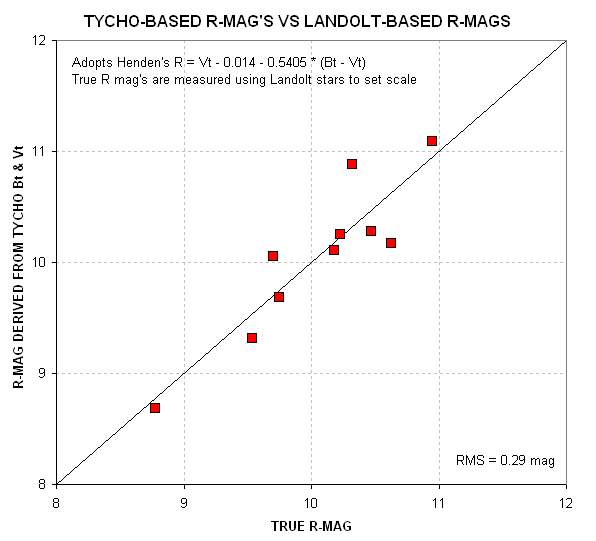PHOTOMETRY FOR DUMMIES: METHOD #4
Bruce L. Gary, Hereford Arizona Observatory (G95)
Last updated 2005.01.02
0.15 to 0.30 mag
SE,
R-Filter, Using
Several Tycho or UCAC2 Reference Stars (10 Minutes)
This method is the same as Method #2 except that catalog magnitudes
have to be converted to an R-magnitude. As stated before, be sure you
have UCAC2 files on
your hard disk and configure your planetarium program to support this
catalog.
1) Locate up to 4 unsaturated stars in your image that have Tycho
magnitudes displayed in your planetarium program. Avoid Tycho stars
with Vt > 10.5.
Note: You may not find any Tycho
catalog star in your FOV if it's smaller than ~15 x 25 'arc.
If you have many images at about
the same air mass try those and use the "zero offset" value for
analysis of the image of interest.
2) Convert Tycho magnitudes Bt and Vt to R using Arne Henden's
conversion equation: R = Vt -0.014 -0.5405 * (Bt - Vt)
3) If you have to use UCAC2 stas, convert UCAC2 V-mag (which I'll refer
to as Vu) and J magnitudes to R using:
R = 0.17 + 0.83 * Vu + 0.14 * J.
(Don't use the Vu 0.25 mag correction mentioned elsewhere.) Estimated
accuracy = 0.30 mag.
4) Set the photometry aperture so that
most of the "light" from the reference stars fall within the signal
circle, and check that
no interfering stars are in the sky background reference annuli.
5) Select the Photometry Tool (in MaxIm DL click Analyze/Photometry).
6) Set the mode to Object and left-click the asteroid.
7) Set the mode to Reference, and for each Tycho or UCAC2 reference
star
left-click it and enter the Tycho-based or UCAC2-based R-magnitude for
that star.
8) Click View, and save the results to a CSV-file.
9) View the CSV-file (using your favorite utility, such as Total
Commander), and read the asteroid's R-magnitude.
Note 1: The more Tycho stars you use the smaller your
systematic error. With just one Tycho star you can expect SEc = 0.30
mag. With 4 Tycho stars it should be ~0.15 mag.
Note 2: This procedure is a lot more work compared with the
procedure for V-filter or unfiltered observations, and the results are
less accurate. This is due to the fact that star catalogs don't
include R-magnitudes (except for the very brightest, which will
always be saturated for CCD users). Converting B and V magnitudes to R
involves additional errors, so the R-mags you calculate are less
accurate than the catalog V-mags. Here's an example of Tycho-based R
magnitudes versus "true" (Landolt-based) R-magnitudes for a region
chosen at random (the Landolt Area at RA = 00:55).

Figure 1. Tycho-based R-mags versus "true" R-mags, where "true"
R-mags were determined using an R-filter image that contained 21
Landolt stars for establishing a zero-shift value.
Note 3: I'm unsure about the accuracy of using UCAC2 stars for
deriving R-magnitudes. If the V-mags have SE = 0.2 mag, and the R-mags
should be even better (since I think they're derived from JHK
magnitudes). I did a quick correlation that indicates 0.15 SE for
R-mags derived from the catalog Vu and J mag's (using the formula given
in step 3, above).
Return to Photometry for Dummies
____________________________________________________________________
This site opened: January 5,
2005. Last Update: January
5,
2005
